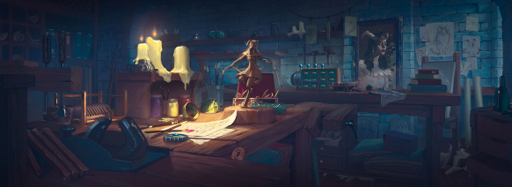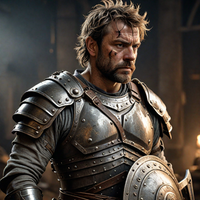When we introduced Sigil, we imagined a powerful 3D virtual tabletop where you could share maps, minis, and environments with your friends and fellow players. While that vision inspired thousands of players and creators, we couldn’t sustain the level of ongoing development support that Sigil—or our community—deserved. That’s on us.
Maybe next time don’t rush a product out of the door and then fire two thirds of the dev team?
Good riddance. It was a transparent attempt to bring mobile app style monitization into D&D.
Is this videogame-esque, 3d battle map tool that they unveiled back around the time of the OGL controversy? I remember being vaguely curious about it after having spent some time playing around with 3d battle mapping using Dungeon Alchemist, but I had already cancelled my DND beyond sub over the OGL stuff, and I wasn’t about to sign back up.
I mean, to take them at their word (which is a dubious proposition with Hasbro/WOTC, I know), I can understand how such a project would be a large undertaking. Furthermore I can see how the ROI may not make sense, as the standard should be unique assets and close integration of every addition a given module makes. Like, if I buy the Tyranny of Dragons (or whichever) module via DnD Beyond, I would expect to be able to open the VTT, click “Load Module”, and have practically all of the prep work for a session done for me.
Hell, I STILL think that would be valuable to me, a lazy DM, but I can acknowledge I’m a subset of a subset, and I’m still not willing to fork over more money to WOTC, so I guess I’ll keep doing the session prep myself, as is tradition.
I don’t think I’ve heard of this before, but from what I’m reading this sounds like a bad idea that doesn’t focus on what makes pen and paper games good.
I don’t want fancy 3d models. I want to use my imagination. I don’t need much more than a dry erase board.
Ed Zitron wrote a post about “Business Idiots”, where he said many of the people making decisions in businesses are out of touch with both the users and the product. I see no reason to doubt that hypothesis.
Worst of All Possible Worlds talks a lot about this as well, that so many business people in charge of making decisions, especially in the gaming universe, simply do not understand the product, the consumer, or the need for the product. Gaming CEOs don’t see anything other than “game with X feature make line go higher”, and don’t really understand WHY a specific game or specific feature is popular - and consequently, this incompetence filters down through the org. Managers tell devs to implement X even if the change is nonsensical or adds no value to the product, because word from On High is that New Feature will sell.
I work in gaming, and I can say with some confidence that, at least at the big publishers, it doesn’t actually work this way. The C-suite, in particular, isn’t talking to developers at all, and aren’t making decisions about products beyond which IPs that they have in their catalogue that they want to put a bunch of money into.
Where the problem is is in the marketing and editorial departments. Most of the big publishers have a department whose job it is is to assess whether unannounced games in development have a viable market, and how to better appeal to that market. The problem is, the people in those deparments don’t use anything but what’s trending right now to determine this, and so you get studios being told that their current game a) should be shoehorned into franchise X or Y, and b) should adopt this mechanic, tone, or aesthetic that doesn’t really fit with the core idea, amd that will be dated by the time the game launches in 2 years.
These are deeply conservative, risk-averse departments, and they gatekeep all of the major development and launch milestones.
D&D isn’t like other RPGs, in that it’s owned by a mega-corp that treats it much more like a business first and foremost rather than as a work of art which just happens to be sold through a business. Only really White Wolf has anything close to the same sort of corporate structure and concomitant problems. So Hasbro sees the fact that playing D&D requires a Dungeon Master, and that finding a DM is often difficult as a Problem to be Solved in order to grow their Customer Acquisition.
To wit: they want(ed) to embrace AI as a way to remove the need for a human DM. Their hope was to leverage this VTT to become an all-in-one portal to playing D&D. That’s part of why the original attempt to change the OGL included heavy restrictions on how other VTTs could use D&D content. Obviously they’ve since backed down on this. Maybe because they realised it was far too expensive to actually build out the VTT. Maybe because they realised people don’t actually want AI DMs. Maybe a bit of both, or something else entirely.
TL;DR:
businesses are out of touch with both the users and the product
bingo.
I don’t want fancy 3d models. I want to use my imagination
Personally, I wouldn’t mind fancy 3D models and animations. In theory. But to use a VTT with them requires much more prep as a GM than just playing theatre of the mind, or on a Paizo flipmat with a few quick dry-erase walls and pillars scribbled on. I want to spend my prep time prepping story, combat balance, and understanding NPC motivations & abilities, not meticulously placing assets on 3D battle maps. And then at the table, I want to be able to reach out in front to a shared space between me and the players, not have to figure out how everyone can look at the same virtual screen.
Even playing online, Roll20 does a much better job of replicating that at-the-table experience with a simple grid that you can hastily draw on if you want. In a fully 3D environment that really isn’t going to work. The chasm between the players’ character tokens and the fancy animations when they cast their abilities, and the white void they’ll be standing in if I don’t spend hours prepping, just isn’t going to create the immersive experience they seem to want.
sig·il /ˈsijəl/
Uh, not quite. The normal English word sigil is pronounced like /ˈsɪdʒəl/ (your /j/ is pronounced like “y” is “yes”, and /i/ is the “y” sound in “happy”), but the city in D&D and the Planescape setting pronounces it /sɪgɪl/, because a designer on their team mispronounced it and they decided to run with that.





